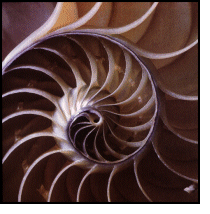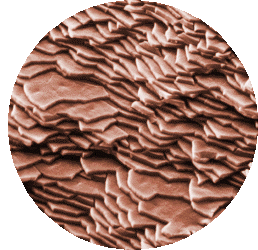Research: Biomimetics and Bioinspired Processing

The biological world has long been a source of inspiration for engineering design. The popularity of designs which mimic natural systems is due, in large part, to advantages in performance. In the past, drawing ideas from nature was limited to macroscopic engineering problems. Advances in analytical techniques over the past several decades have opened the door to understanding the material structure and properties at the molecular level. The wealth of insight provided from these techniques now allows us to mimic natural structures at the microscopic level. Composite materials with structures patterned after biological systems can exhibit significant advantages in strength, durability, hardness, chemical selectivity (including molecular recognition) and other properties, over those exhibited by currently available synthetic materials. New strategies for producing composite materials begin with studies of growth in biological systems.
Our past research has led to the development of improved ceramic fabrication processes, mainly through the use of colloidal dispersion and consolidation methods. Experimentally and theoretically we address fundamental issues on the dispersion of primarily micron-size powders with polymeric processing aids, the consolidation methods, and microstructure evolution in single- and multi-phase systems. However, for all the answers provided, additional questions indicate a new focus on the length scale of 1 to 100 nm (nanometers), which is where our knowledge of designed-materials synthesis and processing is weakest. Since this is also the range where phenomena associated with atomic and molecular interactions strongly influence the macroscopic properties of materials, the main focus of our projects is now on the issues related to the nanodesigning of hierarchically structured ceramic matrix composites by using colloidal dispersions and molecular precursors.
The Ceramics Materials Laboratory is currently interested in understanding and producing organic/inorganic composite materials. Our research is focus on three, interrelated objectives:
- To extend the scale of hierarchical design into the nanometer regime;
- To understand the assembly and templating processes for the design of nanocomposites with desired interfaces and structures (Self-assembly and templating processes); and,
- To develop an understanding of the relationship between hierarchical structure and material properties to facilitate optimization. (Structure-property modeling).
I. Hierarchical Order in the Nanometer Range
The structures of biological composites exhibit hierarchical order at several discrete length scales – from molecular to nanoscopic to microscopic to macroscopic. In the case of biogenic hard materials (e.g., sea shells), soft materials (e.g., proteins, membranes, fibers) organized on length scales of 1-100 nm function as frameworks for the growth of specifically oriented and shaped inorganics (e.g., CaCO3, SiO2, Fe3O4, hydroxyapatite) with small unit cells. The high modulus inorganic phase provides the stiffness while the organic phase enhances toughness. Although the principle of hierarchical design has been applied to synthetic composites, the smallest length scale readily accessible is on the micron scale.
The Ceramics Materials Laboratory is interested in refining existing techniques and developing new ones which allow structural control at a variety of length scales from nanometer to macroscopic. Active research areas include Self-Assembly and Patterning, Self-Healing Materials, and Biosensors.
II. Self-assembly and Templating Processes
Biological systems are known to self-assemble into organized structures at many length scales. At the smallest levels, the resulting structures sometimes act as templates for the growth of other materials. The end result is a layered composite with several levels of structural organization. For example, the structure of an abalone shell consists of layered plates of CaCO3 (~200 nm) held together by a much thinner (<10 nm) "mortar" of organic template. Our interest in the structural properties of seashell is described in the project Mechanical Properties of Seashell.
Another class of biogenic materials in which self-assembly and templating lead to a macroscopic materials system of specialized application is bone. In the project Bone Implant Technology, we seek to use the techniques of rapid prototyping to tailor bone implants with composition and structure similar to those of natural bone.
III. Structure-property relationship modeling
 A host of structure-property models exist to describe the mechanical, electromagnetic, optical and other properties of material systems. However, the biologically-inspired introduction of structural order at multiple length scales presents a problem. Since many material properties (e.g., fracture) do not scale linearly with size, structure at the nanometer scale leads to properties fundamentally different from those based on simple mixing rules or extrapolation from the bulk properties of the constituents.
A host of structure-property models exist to describe the mechanical, electromagnetic, optical and other properties of material systems. However, the biologically-inspired introduction of structural order at multiple length scales presents a problem. Since many material properties (e.g., fracture) do not scale linearly with size, structure at the nanometer scale leads to properties fundamentally different from those based on simple mixing rules or extrapolation from the bulk properties of the constituents.
![]()
![]()
![]() © 2001 Princeton University, Ceramic Materials Laboratory.All Rights Reserved.
© 2001 Princeton University, Ceramic Materials Laboratory.All Rights Reserved.


